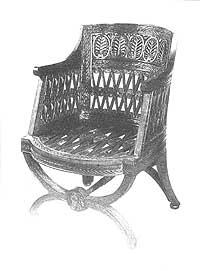From deforestation
The Muslim wooden casetoiduras achieved great fame in Spain and, in the subsequent centuries, these geometric figures provided furniture and interior to the elegant houses of Central and South America.

American mahogany, in principle, was used only in the naval and domestic industry, whose characteristics were unique to these functions. Due to the large size of these trees, logs of great length and thickness could be easily obtained, which also constituted a great advantage. XVIII. At the end of the 20th century it reached the most elegant houses in Europe. By then, carpenters and carpenters realized the tight and compact fibers contained in the caobas, which allowed to work the extremely narrow bony legs, as the taste of the time required.
Then came the turn of African mahogany. XIX. In the eighteenth century, because the wood of tropical America was insufficient to meet the demands, the exploitation of African forests was carried out. African trees belong to species of a different genus (including Khaya and Entandophragma), but their similarity to mahogany wood allows their worldwide recognition and acceptance as mahogany. From Guinea to Angola and from Sudan to Mozambique, in Africa there are five species that give wood of this type.
Wood has to travel a long way between the jungle and furniture. The first task is to cut the tree and once it is knocked down, leave it there until the branches absorb all the water from the trunk. It is then that the journey of the trunk begins. The trees cut in the jungles of the Congo, like the trunks, will intertwine and form almadía in the waters of the Shanga River, to Brazaville and from there, by train, to the Atlantic coast. There, with one part boards and plates will be manufactured and another part will be thrown again. A mixture of insecticide and diesel is injected into the wood before being attached to prevent finger attack. Three weeks later he will arrive in Europe with other noble woods. Gone are the depressed forests.
The Food and Agriculture Organization (FAO) has stated that 7.5 million hectares of forests in the world disappear every year. It is estimated that the original 20 million square kilometers have reached half. Now, only 7% of the land area is covered by forests and 800,000 species of animals and plants live there. And the expurgo continues; poor countries in tropical regions need money quickly and in great need.
These peoples are, on the other hand, the ones that should have the most interest to survive the jungle, one of the pillars of their economy. This is why controlled operating standards have been established. Continuing with the Congo, mahogany logging is not allowed if the diameter of the trunk is less than 80 cm and can not be acted in the same area of the jungle for 10 years.
In addition, for each cut tree you have to pay taxes and 3% of that amount is for reforestation. But, despite its scarcity, it does not meet the marked objective, with which other plantations that have nothing to do with the bureaucracy or the jungle grow.

We will also mention what happened in the Malaysian jungle: With the arrival of monsoon rains into the depressed jungle by the Japanese, the fine layer of fertile soil in the area was dragged and no new trees have been created ever since. It was a great ecological catastrophe.
In Indonesia, retired military personnel receive a piece of jungle in reward. There, despite the laws of forest protection, these people are in a hurry to make effective the small detail they receive and cut and sell the trees as soon as possible, without forgetting the prohibition of exporting logs.
Most of the tropical wood is used in the furniture industry and the naval industry, as well as in floor covering. Several African mahogany trees have ended their lives using acoustic protectors on the German highways.
European environmental organizations have already begun to raise the problem. According to these groups, we must give in and stop using noble woods from Asia and Africa.
Buletina
Bidali zure helbide elektronikoa eta jaso asteroko buletina zure sarrera-ontzian











